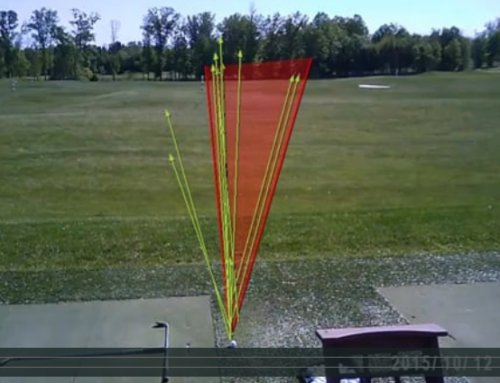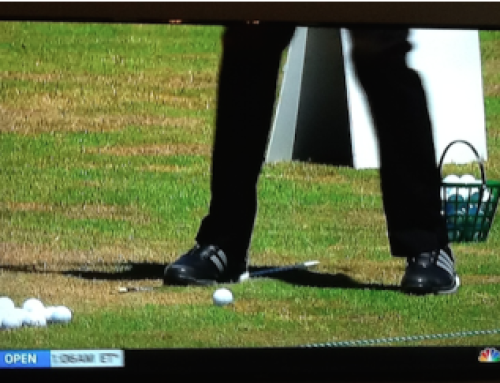 Putting is probably the most important part of the game, a game within a game if you will. Simply put, when you become good at putting your golf game as a whole becomes better.
Putting is probably the most important part of the game, a game within a game if you will. Simply put, when you become good at putting your golf game as a whole becomes better.
When you go out and play golf, and know with certainty, that once you get the ball on or around the green, you have a great chance of holing it. Your golf game improves.
During last year’s (2012) US Open local qualifying, I travelled to Carson City, Nevada. Holes 5, 6, 7 and 8 I struck the ball poorly – I went on a little bad run. But because I believed in my short game and in particular my putting, I managed to hole some very important putts and carded a level par front nine holes.
The important thing to remember here is that I never gave up. I kept my concentration and talked positively to myself to get out of there with some pars and some bogeys.
I birdied the 9th hole, which was a par 5. Because I told myself that was required before I hit my tee shot. I was level par with nine holes to play and I knew three under par, would probably make it through to final qualifying. Pro’s just have a weird sense of what is required on a given day.
I told myself on the 10th tee I needed three under par on the back nine to have any chance of qualifying. I started committing to my swing more on the back nine, as I knew I needed to hit more greens to give myself more opportunities for birdie.
I shot three under par on the back nine to card a 68 (-3) and finished third, from the five qualifiers. I also took exactly the same mentality into my first round US Open Qualifier the previous year in Maryland, and also qualified.
Here’s what I took from those performances: You must have a game plan.
I knew from my practice round exactly how I was going to play those remaining nine holes – or at least try and play them. I knew what shape of shot I was going to hit off each tee to give myself the best possible approach shot into each of the nine greens. I hit 8 out of the 9 greens on the back nine.
Once I was on the green, I already knew I had a great chance of holing the putts simply because of how much I trusted what I was doing.
I forgot about the consequences.
I knew I had a 7 or 8-hour drive back to Southern California after the round. It would have been very easy for me to think after the 8th hole – about how miserable that ride would be after shooting 75 and having a miserable ball-striking day. But I didn’t.
All that was occupying my mind during those final couple of hours on the course was making as many birdies as possible, and having a very pleasant drive back home with a smile on my face.
After I birdied the 17th hole to go three under for the round, it would have been very easy to start thinking about the consequences of slightly drawing or hooking my ball into the water off the 18th tee. I didn’t. I was in total control of my thoughts and emotions and I wasn’t even going to give those negative thoughts the time of day.
I hammered a drive down the right side of the fairway, leaving me a wedge into the green, and I made par. I was actually quite pissed that I didn’t birdie it to be honest. I finished strong, really strong, and it felt great!
I knew it was a make or break situation, and I knew that all of my focus and thought process needed to be on hitting a solid drive up the right side. So that’s what I focused on. I don’t even think I looked at the water running all the way down the left side of the hole. I knew it was there as I played a practice round. And it was demanding my attention when I opened my yardage book up, on the 18th tee. But I channeled my thoughts where they needed to be and got the result because of the process.
Plan to succeed.
All successful people, whether they are professional golfers, other sportsmen and women, businessmen and women, politicians, whoever – plan to succeed before they perform a task. Playing the game of golf is no different.
I spoke briefly about having a game plan, which is critical in planning to succeed. But you must also plan to succeed, before playing every hole, and playing every shot.
If you play off a 18 handicap, and making par on a hole is a great accomplishment. Plan how you are going to make the par, before you play the hole, and don’t forget about making that par whilst playing the entirety of the hole. It’s amazing what setting goals can do.
You may hit a poor tee shot, or hit the ball in the greenside bunker. But if you already have that thought in your mind of making a par, there’s a great chance you will attract that score simply by desiring it so badly. Don’t be surprised if you hit your bunker shot close, and have a tap in for your par. You are simply attracting what you are thinking about. The old saying, “be careful what you wish for” could not be more true.
Follow a Routine
It’s very important from a ‘peace and calm’ perspective of your mind, that you follow a routine. This routine should be practiced A LOT, to make it a habitual process.
On the putting green we can achieve this by simply focusing on the line and speed of the putt. If you are someone who likes a practice stroke to feel the speed with which you are going to hole the putt, great! If you are someone who likes a couple of practice strokes to the side of the ball before making your stroke, this is also fine. It may not be my personal preference, but I’m sure a good player could express why it aids their putting.
If Tiger Woods, who is arguably one of the best clutch putters ever, makes a couple of strokes next to the ball, how can anyone say this is the wrong thing to do?
The truth is, it’s not. It’s merely a routine that people follow. As soon as you start deviating away from a physical or mental routine, it will affect your state. And once your state has been affected, it will change your behavior.
This in turn produces anxiety. This stressful feeling is responsible for not thinking correctly, poor decision-making, missing simple information, etc.
So needless to say, the importance of a routine is paramount when playing good golf.
The type of routine I would like you to start incorporating into your putting game is one of mainly focusing your thoughts on the line and speed of your putt – that’s it!
Once you start to do this, you can actually start to roll the ball into a specific part of the hole, not just the hole itself, therefore, giving you greater room for error in your speed control.
Learn the art of “positive” self-talk.
I’ve worked with thousands of people over the years and some of them specifically on their short game. I’ve spent time on the practice putting green as well as on the golf course with these people and 90% of them do exactly the same thing.
They literally convince themselves they are pathetic putters. They make one or two, or heaven above, three bad putts within the first couple of holes, and talk to themselves in such a negative way, that the mind simply responds to what they are programming it to do.
Our mind is extremely sensitive. If you start telling yourself you can’t make a putt in a month of Sundays, there’s no chance you ever will.
You have to learn the art of talking to yourself positively. This involves changing the way you look at things. Instead of saying things like ‘I’m such a bad putter’ or ‘I couldn’t score in a brothel’. You have to change your self talk to things like ‘I’m going to hole this 8-foot putt for par’ or ‘Let’s get up and down on this hole, for par’.
I know I perform at my best when I talk to myself positively – I want to hole the putt so badly – my eyes are wide open and I’m fully living in the moment.
Don’t forget playing a round of golf takes a long time. During that time you are going to have many conversations with yourself. Make sure you are talking to yourself in a manner that will produce results.
Remember, playing this game well, is in the process, this leads to the results.






